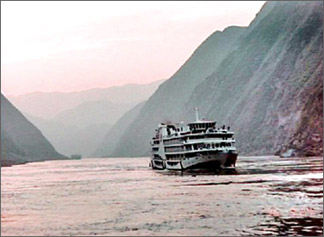Water crisis
 In recent years, one could possibly have forgiven the denizens of the
Arabian Peninsula for forgetting that water was a scarce resource. In recent years, one could possibly have forgiven the denizens of the
Arabian Peninsula for forgetting that water was a scarce resource.
They have been obtaining it by tapping into aquifers - wet
underground layers of permeable rock or unconsolidated gravel, sand, or
silt from which groundwater can be extracted by means of a well or
borehole.
This has enabled them to grow vast acreages of wheat and other crops.
However, now it appears that the aquifers are running dry or becoming
saline.
The problem is that most of them are non-replenishable fossil
aquifers: they were filled by seepage from the surface during the last
ice age. As they are tapped, the water-table drops and salt water seeps
in from the surrounding seas.
 |
|
Yangtze
River. Picture courtesy: Google |
Saudi Arabia was until recently self-sufficient in wheat, but the
growing scarcity of groundwater has caused harvests to drop by two
thirds. Three years ago, in order to conserve its groundwater, the Saudi
government clamped down on pumping and removed subsidies for wheat
production.
Food production
In neighbouring Yemen, water tables are falling by 2 metres per year,
and harvests have fallen by one third. Water is set to replace petroleum
as the Middle-East’s most valuable commodity.
This is not just an Arabian problem. In the USA the huge Ogallalla
Aquifer, which irrigates farms from North Dakota to Texas - America’s
breadbasket - is also running dry and food production could collapse.
In China, which is the world’s largest producer of grain, falling
groundwater has affected harvests. Although the country has
replenishable aquifers, water needs have exceeded the rate at which
these get recharged.
The problem has been compounded by changing weather patterns and
increased times of scarce rain. China is at present in the midst of a
drought. It is the worst seen in the Yangtze River basin for 50 years,
in Shangdong - a province 21/2 times the size of Sri Lanka - the worst
in two centuries.
Irrigation systems
In the US breadbasket, the shortage of aquifer water has been
exacerbated by a series of droughts over the past 13 years, the worst of
which seems to be this spring’s. In Texas and the Southwest states, in
Oklahoma and Kansas, this unprecedented dry spell is expected to bring
harvests down by as much as 50 percent.
Meanwhile, the wheat heartland has not had significant rainfall since
last July, not very far distant the Mississippi River has been flooding
- an aberrant climatic pattern which is becoming familiar all over the
world.
This is also a pattern which has been seen here in Sri Lanka. Despite
the fact that our island is so tiny, it has a relatively large variety
of climate zones. Historically, rains from the mountains fed the rivers
and irrigation systems of the Dry Zone even in the absence of rain.
Now, however, rainfall patterns appear to be taking on a much more
peculiar shape. This year there was increased rainfall in April, usually
a dry month, leading to floods. Conversely, the South West Monsoon, the
onset of which is usually in mid-May, has been delayed.
Rice varieties
An estimated quarter of the last Maha season’s harvest of paddy was
destroyed by excessive rain and flooding. This pattern can be expected
to repeat itself in coming years.
Aggravating the problem of erratic rains is the fact that
deforestation has severely impinged on the water-retention capacity of
the highland watersheds. The aftermath of heavy precipitation is that
the rainwater, instead of being held by the soil on hillsides, flows
down and into the rivers, causing floods.
There is also a developing shortage of groundwater. This is not so
much a result of the depletion of the water table - Sri Lanka’s aquifers
are replenished by water seepage from the surface - as it is of
pollution.
Agriculture in this island, particularly the cultivation of rice -
has come to be dominated by agro-chemical usage. The new rice varieties
introduced since the beginning of the ‘Green Revolution’ in the ‘60s
require large quantities of fertiliser. They are less resistant to pests
and diseases, so they require huge amounts of pesticides.
These toxic chemicals trickle down through the soil and into the
aquifers, which they contaminate. Over the past half-century, the
accumulation of these noxious substances in the groundwater has led to
decreased potability - so there is now a growing shortage of drinking
water.
Rainwater harvesting
The crisis in water supply needs to be tackled immediately. There are
several techniques by which the different aspects of the problem may be
addressed.
Obviously, the best way to counteract increasingly erratic rainfall
patterns is to make sure there is adequate storage for excess water when
it rains so that it can be used in periods of drought. This was the
system adopted by the ancient kings with their network of canals and
tanks.
This rainwater harvesting can also be done on a small-scale or
household level. Legislation has already been passed requiring rainwater
harvesting to be catered for in new construction plans, but this does
not affect existing buildings.
The reforestation of the highlands as part of an improved system of
watershed management provides the best long-term solution to the dual
problem of excessive flooding combined with drought.
Probably the most difficult issue is cleaning up the contaminated
aquifers, which will require the minimising of agro-chemical usage. This
will require new rice varieties (possibly by breeding versions of the
old ‘Sinhala vee’) and greater use of organic manures and natural pest
control.
The Government could set the ball rolling by targeting selected
areas, in which the fertiliser subsidy could instead be used to fund
organic farming techniques.
|



